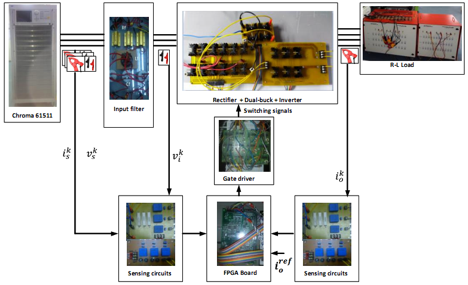Title: Model Predictive Current and Reactive Power Control Fed by Multilevel Four-leg Indirect Matrix Converter Operating Under Unbaalanced Voltage Supply
This research works focused on model-based predictive current control which was applied to indirect matrix converter. Indirect matrix converter (IMC) is an alternative solution of conventional ac/ac converter. Its energy storage-less structure enables the construction of a compact power converter circuit. The feature of IMC was extended with multilevel concept to improve the output waveform quality by unifying the conventional four-leg indirect matrix converter with a four-switch circuit resembling a dual asynchronous buck-circuit to synthesise the multilevel output voltage. The unbalance voltage supply posed a real challenge in implementing the ac/ac power converter. In practice, the matrix converter is supplied by the utility grid which is prone to become unbalance due to the asymmetric load connected to the grid. Being energy storage-less solution, the unbalance voltage supply has a direct effect on the load current regulation due to the fluctuated active and reactive power. Hence, there is strong mutual coupling between the supply and the output. Any disturbance in the input volt ages can be immediately reflected to the output voltages. For most of the modulation strategies, the unbalanced and non-sinusoidal input
voltages can cause unwanted output harmonic voltages. This study is aimed to maintain excellent load current reference tracking while minimising the instantaneous reactive power for both balance and unbalance voltage supply. In order to achieve this objective, the conventional cost function was properly modified to adapt to the unbalance supply voltage. The predictive algorithm computes the one-step prediction load current and reactive power. The proposed control strategy uses the discrete nature of the system to predict the future load current and reactive power behaviour to perform switching optimisation using a minimum cost function criterion. This study proposed an optimized rectifier switching strategy to ensure positive fictitious dual dc-link voltage at any instant and reduce the computational burden of the controller. In order to evaluate the robustness of the proposed control, different combinations of balance or unbalance supply voltage
with balanced or unbalanced loading conditions were pre-validated using Matlab/Simulink®. It is followed by an FPGA based experimental works to validate the proposed control scheme. The integration of this circuit has resulted in a significant reduction of current harmonics. the four-leg structure, the proposed topology was adequate for balance or unbalance load. Moreover, the modified cost function enabled an optimum reactive power minimisation throughout the wide range of voltage supply unbalance. The experimental assessment confirmed that the proposed control could cater for the wide range of degree of unbalance. In addition, it revealed an outstanding load current reference tracking with harmonics distortion below 5% while maintaining
relatively small instantaneous reactive power. Findings from this study is that, subject to sufficient active power, outstanding load current tracking was achieved, and the instantaneous reactive power can be optimally reduced. The proposed system exhibits 𝑇𝐻𝐷𝑣𝑜% below 30% and 𝑇𝐻𝐷i𝑜% below 5% based on IEEE S td 519™ -2014 and IEC 61000-3-6. This study makes noteworthy contribution to the ac/ac conversion that can be applied to systems such as wind turbine and hydro power plant.

Last Update: 22/11/2022